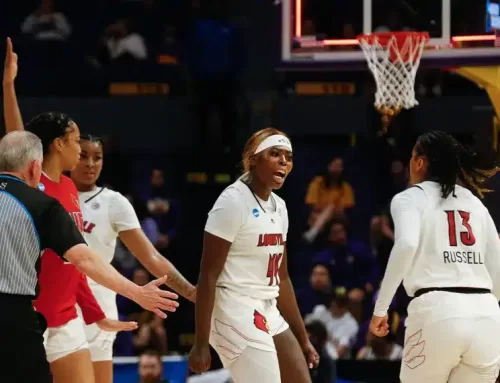This article is the first part of a three-part series. Read Part Two and Part Three here.
By Simon Isham —
The fall semester has seen major reorganization in the staff U of L’s Cultural Center, the primary arm of the university dealing with minority students. The rearrangement has caused at least one student organization to mobilize in favor of expanding the space to better serve students of diverse backgrounds.
The Cardinal has, since September, spoken to an assortment of university personnel regarding the enrollment, retention and graduation of students of color here.
Some have heralded U of L as the most diverse institution of higher learning in the state of Kentucky. If this is true, exactly what kind of diversity does the university have? And what efforts will be needed on the part of the faculty, staff, students and administrators to sustain its growth?
The Cultural Center at U of L officially opened on July 1, 2008. As a part of the 2020 Plan — which has now been updated to its present form, the 21st Century Initiative — the center was charged with “provid(ing) advocacy for our students, celebrat(ing) the diverse cultures of the campus community, engag(ing) students in social justice issues, and support(ing) the scholarship and retention of U of L students,” according to the Cultural Center website.
But the advent of the Cultural Center was hardly sudden; previous iterations of the program were known as the Office of Black Affairs from 1970 to 1976, and from 1976 to 2008 as the Office of Minority Affairs, a part of the Multicultural Academic Enrichment Program.
The program was shepherded from its beginnings by former Dean of Arts and Sciences Dr. J. Blaine Hudson, who passed away in January of this year. University Archivist and Metro Councilman Tom Owen recalled that Hudson had worked in the Office of Black Affairs as a tutor in the spring of 1970, shortly after it was created.
In 1992, Hudson accepted a teaching position in the Pan-African Studies department, retaining close ties to the program, which had by then been re-dubbed the MAEP. In 2005, Hudson was promoted to dean, and in 2008 saw the second rebranding process as the MAEP became the present-day Cultural Center.
Vice-Provost for Diversity and International Affairs Mordean Taylor-Archer, who arrived at the university in 2003, made and announced the 2008 decision to terminate the existing program, citing the university’s desire to improve quality of services.
That decision also caused a reshuffle of university employees. At the time, U of L spokesman John Drees told the Cardinal that MAEP and Minority Affairs employees would have to reapply for jobs within the university. The fall 2013 semester has seen further — albeit less extensive — staff changes, including the hiring of a new director.
Tierney Bates, a transplant from Ohio via Tennessee, began the semester as the new director of the Cultural Center. He said he believes that improving academics should be an integral part of his organization’s mission.
“I’ve worked in cultural centers before coming here, and a lot of cultural centers have an academic piece, and we were missing that academic piece … If you look at most REACH-type programs, they started in cultural centers. They started off as tutorial programs and services and stuff like that. When they became successful, (administration) said, ‘Why don’t we broadcast this to all of campus?’ What we’re trying to do (at U of L) is bring it back to being successful for students of color in-house,” he said.
Bates also said he hopes to help improve the graduation rate of U of L’s black student population.
“If you look at four- and six-year graduation rates for African-American students (at U of L), six-year graduation rates are high, but that four-year is very low … Six-year is what we’re judged upon from a higher education standpoint, but I want to go back and benchmark against other student groups and universities.”
He also noted that students who are unable to keep up their GPAs may be ejected from their scholarship programs, rendering them unable to pay for college and contributing to the problem of the attrition of students of color.
Bates’ requests to bring academic resources into the center were answered in September, when two employees of REACH, Vickie Bridgeman and Jackie Sidney, were told that their positions were being transferred to the Cultural Center with one month’s notice. Bridgeman said that she and Sidney were not given the option to keep their old positions, and that the transfer decision was made by Provost Shirley Willihnganz and Vice-Provost Taylor-Archer.
When asked why she was told to make the move, Bridgeman said that she thought the decision was precipitated by a rumored influx of Hispanic and Latino students to the university in 2014 and 2015, and the desire to be prepared for such a situation.
Bridgeman clarified the difference between her former job in REACH and her new one in the Cultural Center:
“REACH is more tutorial, whereas we’re more like coaches … We were already seeing Porter (Scholars), we were already seeing our Hispanic and Latino students in REACH. We don’t want to take anything away from REACH,” she said.
Bridgeman now serves as the senior associate director of the Cultural Center. She has worked at the university for 29 years in a variety of departments and capacities, but is now responsible for increasing the retention rates of the students that the Cultural Center serves. She is also in charge of the Excel program, the university’s coaching system for first-year students who do not meet the academic requirements for outright admission but have been admitted by exception.
Sidney declined to be interviewed for this article. The Cultural Center website lists her as senior academic counselor, and says she “assists first year students in anticipation of a good transition from high school to college. She offers support and encouragement and directs students to campus resources as needed.”
This semester, Association of Black Students President De’Jon Day submitted a petition to social advocacy site Change.org, requesting that U of L administration build a bigger Cultural Center. Day acknowledged the addition of Bridgeman and Sidney to the Cultural Center staff in the petition text.
“Since its opening in 2008, the Cultural Center has been the hub for students of color including many of the African-American student organizations,” said Day. “Since then the number of students and the organizations have increased, both in impact and membership. To better provide support for these students and increase graduation (and) retention numbers the Cultural Center recently added two additional staff members. While this is great because more support, programming and coaching will be provided to students, space available for students will decrease.”
Currently, said Day, there are three spaces in the Cultural Center where student organizations can congregate: the student lounge, the multipurpose room and the conference room.
According to U of L archives, the building which now contains the Cultural Center was built in 1950 as the Builders Exchange of Louisville before being acquired by the university in 1968 as the music history building. In 1976, the building became the offices of Minority Affairs, the precursor to the current Cultural Center. It is 4,920 square feet.
When asked about current participation in Cultural Center activities, Bates said that while U of L’s surrounding community is supportive, he and his staff would like to see more students attend and spend time in the center.
As of print date, Day’s petition had 98 signatures, of a possible 100. If and when 100 signatures are reached, the petition will be delivered to Provost Shirley Willihnganz and Vice-Provost Taylor-Archer.
Taylor-Archer said she believes the recent changes to Cultural Center staff will help the center better adapt to changing student need.
“The Cultural Center has capable staff and a visionary director in place who will use proven best practices to help reach the goals; however, the goals cannot be accomplished by the Cultural Center alone. These are shared goals and will require collaborations with other units across the university,” she said. “As Vice Provost for Diversity and International Affairs, I will seek the resources needed to help undergird the success of programs and will work with Tierney (Bates) in monitoring and evaluating programmatic outcomes. I meet with Tierney regularly but will also attend some student meetings in order to communicate with them.”
Bates echoed Taylor-Archer’s sentiment that improving the situation at U of L will require serious cross-departmental collaboration. He told the Cardinal that he and his office are interested in working with many offices across the university, including Admissions.
Look for part two in the Jan. 14 issue.





